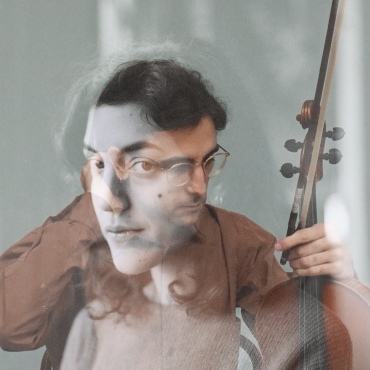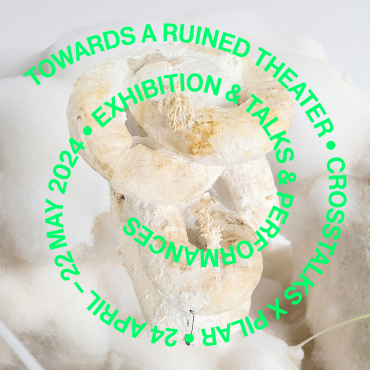Breadcrumb
- Home
- Project
- Towards ruined theater 2024
CHAIR CASTERMAN-HAMERS: HISTORY AND PHILOSOPHY OF SCIENCES
Towards a Ruined Theater
Exhibition - Talks - Performances
Ⓒ Deborah Robbiano
Towards a Ruined Theater (2024)
Beneath our feet lies a hidden world, a marvel of nature woven from microscopic threads that collectively form mycelium. This intricate network serves as the unseen architect of our planet, shaping ecosystems for hundreds of millions of years. The power of mycelium lies in its ability to connect and transform. It plays a crucial role in decomposing organic material, returning essential nutrients to the soil, fostering healthy ecosystems, and ensuring an endless cycle of life and growth.
In Towards a Ruined Theater, architect Sébastien Tripod, graphic & floral designer Deborah Robbiano, and choreographer and researcher Sara Manente collaborate on this installation about fungal imagery. Having created architectural fungi columns before, they now aim to imagine an entire theater in collaboration with fungi and molds. Imagine a theater as a ruin: a place constantly changing, like a garden through the seasons, in an infinite cycle of growth and decay. A situation creating space for questions, metaphors and images around contamination and finality. Is every encounter a form of contamination? Is every performance a ruin that could bring fruit?
In addition to this imaginary theater various scientific and artistic projects demonstrate how mycelium can be used as an active component, with the potential to reform our material culture and way of life. They represent the current state of research on mycelium and are the result of collaboration with the VUB Microbiology Research Group (MICR).
An example of such innovative process is self-healing concrete, based on fungi. Although concrete is a widely used building material, it often suffers from cracks leading to corrosion and material degradation. PhD researcher Aurélie Van Wylick explores a promising solution to enhance its durability by using fungi as self-healing living material. Also showcased in the exhibition is research by postdoctoral researcher Elise Elsacker and PhD researcher Simon Vandelook, seeking ways to transform mycelium into a material resembling leather. The goal is to create a fully natural, biodegradable material.
The exhibition also features a concert and a talk.
On Friday, May 17th, Victor Guaita and Clara Levy will present their interpretation of one of the greatest song collections from the Middle Ages, the Cantigas de Santa Maria. The performance explores various aspects of the songbook: music, poetry, iconography, history, etc.
On Wednesday, May 22nd, Giuliana Furci, Sara Manente, and Augusto Corrieri will delve into the intersection of fungal studies, contemporary performance, and ecological awareness. They invite the audience to reconsider their relationship with the living world and contemplate the potential of the fungal realm. The discussion will be moderated by Dr. Eylül Fidan Akıncı.
PRACTICAL
The exhibition takes place from April 25 until May 22 at Pilar.
- Location: Pilar Expo (First & Second Floor) - Triomflaan, VUB Entrance 6, 1050 Brussels
- Entrance exhibition: Free
- Opening hours: WED—SAT: 14:00—20:00. Closed on May 1.
- Vernissage: Wednesday April 24, 18:00
- Side events from April 24 until May 22 at Pilar, Sara Manente invites makers and thinkers at a number of moments to activate the installation in different ways. Have a look at the 'Event' tab on this page.
- Organized by Pilar x VUB Crosstalks, in collaboration with Kaaitheater as part of A Series of More-Than-Human Encounters. Curated by Sara Manente, Sébastien Tripod and Deborah Robbiano, with contributions from the Research Group of Microbiology VUB.
BIOS
Sara Manente studied dance and semiotics before coming to Brussels, where she works as an artist and researcher. Her projects start from the images and matter of living cultures and fungi in relation to performing arts. In different formats, she reflects on the possible contagion/transfer between pedagogy, research, performance and publication.
Deborah Robbiano is a multidisciplinary artist who works with found objects, both natural and man-made, to create vegetal sculptures, sets and installations. In her work, she lets chance encounters and the longevity of plants guide her process. Each element is abstracted from its original form and purpose. This shift allows her to celebrate the ephemerality in the many stages of vegetal transformation.
Sébastien Tripod graduated from the Joint Masters in Architecture of the University of Applied Sciences and Arts of Western Switzerland and the Luca School of Arts in Ghent. He collaborates with various groups for projects in residence, advocating environmental and social ecology. Closely associated with the knowledge of craftsmanship, interested in traditional building techniques and the use of low technology, he works as an independent architect, based in Lausanne since 2018.



